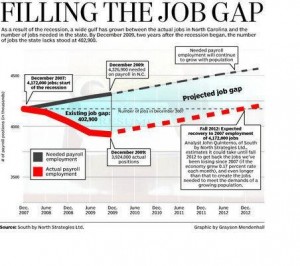08.02.2010
Policy Points
Economic policy reports, blog postings, and media stories of interest:
08.02.2010
In the News, Policy Points
A front-page story in yesterday’s issue of The Durham Herald-Sun asks just how big of a “job gap” North Carolina is facing. The piece draws heavily on the work of South by North Strategies, Ltd., especially its research into labor market conditions.

08.02.2010
Policy Points
A story in the Triangle Business Journal explains the surge in enrollments occurring throughout North Carolina’s community college system. When coupled with funding reductions, this trend effectively is causing the system to turn students away for the first time in its history. Reports the Business Journal:
The institutions have reached capacity in almost all fields, and they lack instructors, desks and lab space to take on any more students. While the schools remain committed to the goal of open enrollment – no student is told he or she cannot sign up for a class – the schools are struggling to find space in some classes that students want to take.
—
“We theoretically don’t turn anyone away,” says Stephen Scott, president of Wake Technical Community College. “But realistically, that’s what happens. We’re trying to come up with ways to just have a place to put them.”
—
The colleges say they are doing what they can to try to address the problems. They’ve asked instructors to teach more classes. They’ve hired more adjunct professors, who are less expensive to employ. They’ve pushed class sizes to the maximum number that a classroom or instructor can handle. They’re adding courses between 2 p.m. and 6 p.m., when demand for classes is typically low. And they’re promoting the system’s online courses.
08.02.2010
Policy Points
In The American Prospect, Robert Kuttner looks at the politics of federal deficit reduction and how proposed solutions are alarmist and ultimately self-defeating. Argues Kuttner:
Long-term fiscal balance is necessary policy, but we can reduce the debt burden without slashing social outlay. That’s exactly what we did during the quarter–century boom after World War II, when we combined high growth rates, modest budget deficits, progressive taxation, a declining debt burden — and increases in social spending. That growth was partly driven by public investment.
—
The current argument about deficits and debts conflates several entirely distinct issues. Do we need bigger economic stimulus now to promote a faster recovery? (Yes.) Should we reduce deficits and the ratio of debt to GDP once a strong recovery comes? (Yes.) Does this require an extra-legislative commission? (No.) Do we need to slash social insurance in order to achieve fiscal balance? (No.) Are there other ways to get to a sustainable budget? (Most definitely.)
05.02.2010
Policy Points
A round-up of policy reports from the week ending on 2/5:


 Email Sign-Up
Email Sign-Up RSS Feed
RSS Feed